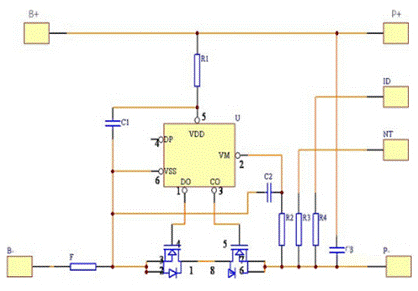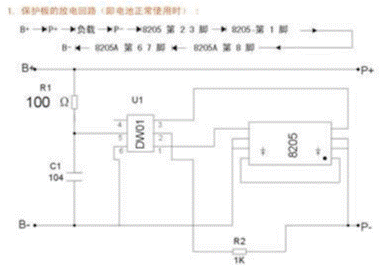12V lithium battery protection board
12V lithium battery protection board, 16 series lithium iron phosphate battery protection board, 18650 battery protection board, and circuit board manufacturers will give priority to the working principle of lithium battery protection board when designing double-sided circuit boards. The City of Batteries will show you the principle of a single cell lithium battery protection board, hoping to draw inferences from one example to another.
The circuit and parameters of the lithium battery protection board are different according to the use of IC, voltage and other factors. DW01 is distributed with MOS tube 8205A, including the normal working behavior of the lithium battery protection board.
1. Working principle of lithium battery protection board
When the cell voltage is between 2.5V and 4.3V, both pin 1 and pin 3 of DW01 output high level (equal to the supply voltage), and the voltage of pin 2 is 0V. At this time, the voltages of the first and third pins of DW01 will be applied to the fifth and fourth pins of 8205A respectively. Because the G pole of the two electronic switches in 8205A is connected to the voltage from DW01, they are both in the on state, that is, both electronic switches are in the on state. At this time, the negative pole of the electric core is directly connected with the P-terminal of the protection plate, and the protection plate has voltage output.
2. Overdischarge protection control principle of protective plate
When the electric core discharges through the external load, the voltage of the electric core will slowly decrease. At the same time, DW01 will monitor the voltage of the electric core in real time through R1 resistance. When the voltage of the electric core drops to about 2.3V, DW01 will consider that the voltage of the electric core has been in the state of over discharge voltage, and immediately disconnect the output voltage of the first pin, so that the voltage of the first pin becomes 0V. The switch tube in 8205A is closed because the voltage of the fifth pin is not available. At this time, the B - of the electric core and the P - of the protection board are disconnected. That is, the discharge circuit of the electric core is cut off, and the electric core will stop discharging. The protection board is in the over discharge state and remains in the state. After P and P of the protection board are indirectly charged, DW01 immediately stops the over discharge state after detecting the charging voltage through B -, and outputs the high voltage at the first pin again to make the over discharge control tube in 8205A conductive, that is, the B of the cell is reconnected with P of the protection board, and the cell is charged directly through the charger.
3. Control principle of overcharge protection of protection board
When the battery is charged normally through the charger, the voltage of the battery cell will become higher and higher with the increase of charging time. When the voltage of the battery cell rises to 4.4V, DW01 will consider that the voltage of the battery cell has been in the overcharge voltage state, and immediately disconnect the output voltage of the third pin, so that the voltage of the third pin becomes 0V. The switch tube in 8205A is closed because the voltage of the fourth pin is not available. At this time, the B - of the electric core and the P - of the protection board are disconnected. That is, the charging circuit of the cell is cut off, and the cell will stop charging. The protection board is in the overcharge state and remains. After P and P of the protection board indirectly discharge the load, although the overcharge control switch tube is closed, the positive direction of its internal diode is the same as that of the discharge circuit, so the discharge circuit can discharge. When the voltage of the cell is lower than 4.3 V, DW01 stops the overcharge protection state and outputs the high voltage on the third pin again, making the overcharge control tube in 8205A conductive, that is, the B of the cell is reconnected with the protection board P, The electric core can be charged and discharged normally.
4. Control principle of short-circuit protection of protection board
In the process of external discharge of the protection plate, the two electronic switches in 8205A are not completely equivalent to two mechanical switches, but equivalent to two resistors with very small resistance, which are called the on internal resistance of 8205A. The on internal resistance of each switch is about 30mU 03a9, which is about 60mU 03a9 in total. The voltage applied to the G pole actually directly controls the on resistance of each switch tube. When the G pole voltage is greater than 1V, The on resistance of the switch tube is very small (tens of milliohms), which means that the switch is closed. When the G pole voltage is less than 0.7V, the on resistance of the switch tube is very large (several M Ω), which means that the switch is off. The voltage UA is the voltage generated by the conduction internal resistance and discharge current of 8205A. As the load current increases, the UA will inevitably increase, because UA0.006L&TIMes; IUA is also called 8205A tube voltage drop. UA can simply indicate the discharge current. When it rises to 0.2V, it is considered that the load current has reached the limit value, so the output voltage of the first pin is stopped, the discharge control tube in the first pin voltage becomes 0V and 8205A is closed, the discharge circuit of the electric core is cut off, and the discharge control tube is closed. In other words, the allowable output current of DW01 is 3.3A, realizing overcurrent protection.

5. Lithium battery protection board over-current protection
During the normal discharge of the battery to the load, when the discharge current passes through two MOSFETs in series, a voltage will be generated at both ends of the MOSFET due to the conduction impedance of the MOSFET. The voltage value U=I * RDS * 2. RDS is the conduction impedance of a single MOSFET. The "V -" pin on the control IC detects the voltage value. If the load is abnormal for some reason, the loop current will increase, When the loop current is large enough to make U ≥ 0.1V (the value is determined by the control IC, and different ICs have different values), its "DO" pin will change from high voltage to zero voltage, making T2 turn from on to off, thus cutting off the discharge loop, making the current in the loop zero, and playing the role of overcurrent protection.
It is found that there is also a delay time between the time when the control IC detects the occurrence of overcurrent and the time when the T2 signal is turned off. The length of the delay time is determined by C2, usually about 13 milliseconds, to avoid misjudgment due to interference. It can be seen from the above control process that the size of its overcurrent detection value depends not only on the control value of the control IC, but also on the conduction impedance of the MOSFET. When the conduction impedance of the MOSFET is larger, the overcurrent protection value of the same control IC is smaller.
6. Short circuit protection control process
Short circuit protection is a limit form of overcurrent protection. Its control process and principle are the same as that of overcurrent protection. Short circuit is equivalent to adding a small resistance (about 0 Ω) between P P and P P to make the load current of the protection board reach more than 10A instantaneously, and the protection board will be protected against overcurrent immediately.
Principle and Application of Lithium Battery Charging Circuit
Lithium ion batteries are widely used in mobile phones, video cameras, laptops, cordless phones, power tools, remote control or electric toys, cameras and other portable electronic devices due to their excellent characteristics.
Lithium battery, nickel cadmium and nickel hydrogen rechargeable battery:
The cathode of lithium ion battery is graphite crystal, and the anode is usually lithium dioxide. During charging, lithium ions move from the positive electrode to the negative electrode and are embedded in the graphite layer. During discharge, lithium ions move away from the inner negative electrode surface of the graphite crystal to the positive electrode. Therefore, lithium always appears in the form of lithium ion rather than metal lithium during the charging and discharging process of the battery. Therefore, this battery is called lithium ion battery, or lithium battery for short.
Lithium battery has the advantages of small size, large capacity, light weight, pollution-free, high single voltage, low self discharge rate, and many battery cycles, but it is expensive. Nickel cadmium batteries are being phased out due to their low capacity, serious self discharge and environmental pollution. NiMH battery has a high performance price ratio, and does not pollute the environment, but its single voltage is only 1.2V, so its use range is limited.
|
Disclaimer: This article is transferred from other platforms and does not represent the views and positions of this site. If there is any infringement or objection, please contact us to delete it. thank you!
中恒科技ChipHomeTek
|


